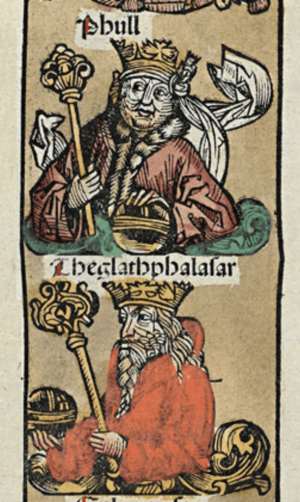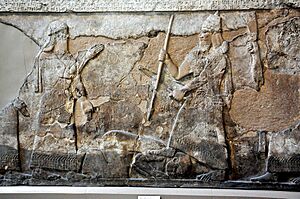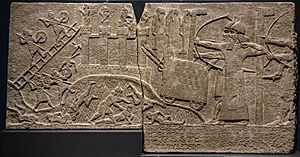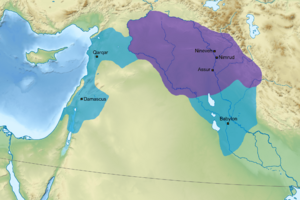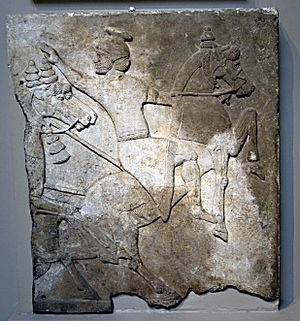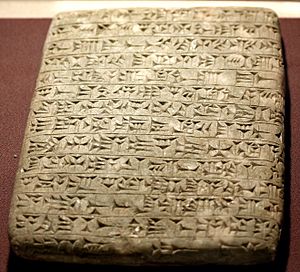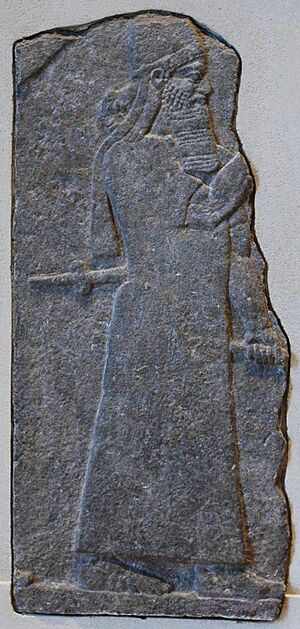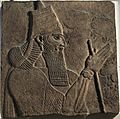Tiglath-Pileser III facts for kids
Quick facts for kids Tiglath-Pileser III |
|
|---|---|
|
|
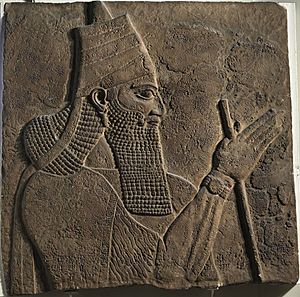
Tiglath-Pileser III as depicted on a stele from the walls of his royal palace
|
|
| King of the Neo-Assyrian Empire | |
| Reign | 745–727 BC |
| Predecessor | Ashur-nirari V |
| Successor | Shalmaneser V |
| Born | c. 795 BC (?) |
| Died | 727 BC (aged c. 68) |
| Spouse | Iaba |
| Issue | Shalmaneser V Sargon II (?) Sin-ahu-usur (?) |
| Akkadian | Tukultī-apil-Ešarra |
| Dynasty | Adaside dynasty |
| Father | Adad-nirari III or Ashur-nirari V |
Tiglath-Pileser III was a powerful king of the Neo-Assyrian Empire. He ruled from 745 BC until his death in 727 BC. His name in the ancient Akkadian was Tukultī-apil-Ešarra. This name means "my trust belongs to the son of Ešarra".
Tiglath-Pileser is one of the most important Assyrian kings. He ended a time when Assyria was not growing. He made many changes to the government and the army. He also doubled the land controlled by Assyria. Many experts believe his rule marked the true start of Assyria as a huge empire. His new ideas helped not only future Assyrian kings but also other empires for thousands of years.
It is not fully clear how Tiglath-Pileser became king. Ancient Assyrian writings give different stories about his family. There was also a revolt around the time he took power. Because of this, many historians think he was a usurper. This means he took the throne from his predecessor, Ashur-nirari V. Ashur-nirari V might have been his brother or his father. Other historians think he might have become king in a normal way. The debate about this is still ongoing.
Early in his reign, Tiglath-Pileser made the king's power stronger. He did this by reducing the influence of important officials. After some small wins in 744 and 743 BC, he defeated the Urartian king Sarduri II. This big victory happened near Arpad in 743 BC. Urartu had been as strong as Assyria for a short time. Sarduri had even defeated Tiglath-Pileser's predecessor eleven years earlier. After beating Sarduri, Tiglath-Pileser focused on the Levant area. Over several years, he conquered most of the Levant. He defeated and took over many powerful kingdoms. One important kingdom he ended was Aram-Damascus. Tiglath-Pileser's actions in the Levant are even written about in the Hebrew Bible. After a few years of fighting, he conquered Babylonia in 729 BC. He became the first king to rule both Assyria and king of Babylon.
Contents
How Tiglath-Pileser Became King
His Family and Taking the Throne
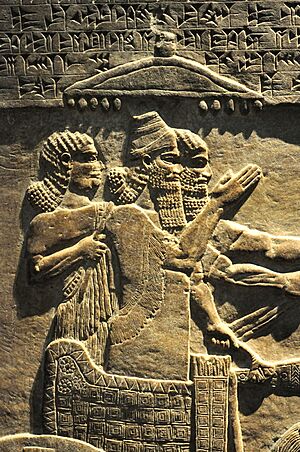
We do not have enough old writings to know exactly how Tiglath-Pileser III became king. Many clues suggest he might have taken the throne by force. For example, there was a revolt in Nimrud, the capital city, in 746/745 BC. Also, many officials were replaced after 745 BC.
Ancient Assyrian records also give different information about his family. The Assyrian King List says his father was Ashur-nirari V. But Tiglath-Pileser himself wrote that he was the son of Adad-nirari III. This would make him Ashur-nirari's brother.
Most historians believe Tiglath-Pileser took the throne by force. Some think he might not have been part of the royal family at all. However, others believe his claim to royal family ties was true. This means he might have won a civil war within the royal family. After he became king, there were no known rebellions against him.
If he was part of the royal family, it is still unclear if he was the son of Adad-nirari or Ashur-nirari. Some historians think he was Adad-nirari's son. They believe the King List might have a mistake. But other experts find this unlikely because 38 years passed between their reigns. It is possible "son" meant "grandson" in this case. Or he might have been quite old, around 50, when he became king.

The Eponym Chronicle is a list of officials who gave their names to each year. It confirms a revolt in Nimrud the year before Tiglath-Pileser became king. Historians think this means he took the throne in a sudden power grab. The revolt might have started with his knowledge. The first official he appointed in 744 BC was the governor of Nimrud.
Some historians suggest that Tiglath-Pileser's rule might have been fully legitimate. He might have even ruled with Ashur-nirari for some time. The Eponym Chronicle shows unusual patterns in his early reign. This could mean he did not become the only ruler until 744 BC. Both the Eponym Chronicle and the Assyrian King List say Ashur-nirari ruled for 10 years. This is only possible if he ruled until 744 BC. If Ashur-nirari ruled until 744 BC, a civil war is unlikely. Tiglath-Pileser was already fighting foreign enemies during this time.
What's in a Name?
For a long time, Assyria was mainly known through the Hebrew Bible. So, Assyrian kings mentioned in the Bible are known by their Biblical names today. Tiglath-Pileser comes from the Hebrew name Tīglaṯ Pīl'eser. This is a changed form of his original Akkadian name, Tukultī-apil-Ešarra.
Tukultī-apil-Ešarra was likely a regnal name. This is a special name a king takes when he starts to rule. It means "my trust belongs to the son of Ešarra." Ešarra was a temple for the god Ninurta. Ninurta was seen as the son of the main Assyrian god, Ashur.
Some old texts, like the Ptolemaic Canon, call Tiglath-Pileser by the name Pulu. The meaning of Pulu is not clear. There is no proof that this name was ever used officially by Tiglath-Pileser. No Assyrian king is known to have used more than one regnal name. Some experts think Pulu might have been his original name before he became king. Or it could have been a nickname.
Assyria Before Tiglath-Pileser
Assyria first became a strong state around the 14th century BC. This was during the Middle Assyrian Empire. Before that, it was just a city-state around the city of Assur. From the 12th century BC, the Middle Assyrian Empire started to decline. It became smaller, mostly just the Assyrian homeland.
This decline stopped at times with strong warrior-kings. But their conquests did not last. The start of the Neo-Assyrian Empire is usually marked by the rule of Adad-nirari II (911–891 BC). Under the early Neo-Assyrian kings, Assyria slowly took back its old lands. This was a huge achievement, as they had to rebuild the empire.
Under Ashurnasirpal II (883–859 BC), the Neo-Assyrian Empire became the strongest power in the ancient Near East. His son, Shalmaneser III (859–824 BC), expanded Assyrian lands even more. But his large empire was hard to control. His last few years saw new problems and a decline. This included both outside attacks and internal conflicts.
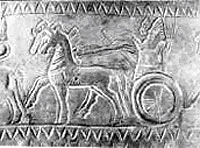
Two main problems for Shalmaneser were the rise of the kingdom of Urartu and the growing power of Assyrian officials. Urartu became a threat because many smaller states saw it as an alternative to Assyrian rule. Urartu's government and culture were very similar to Assyria's. Both empires wanted to expand, leading to many battles.
The Urartian army was as strong as Assyria's for a short time. In 754 BC, the Urartian king Sarduri II defeated the Assyrian army. This happened under Ashur-nirari V at Arpad. This defeat might have stopped the Assyrian army from campaigning for several years. Assyrian kings could not deal with outside threats. This was because powerful officials had become too strong.
The reigns of Tiglath-Pileser's three predecessors were a low point for Assyrian royal power. During this time, a top general named Shamshi-ilu even took credit for military victories himself. Ashur-nirari V did not do much as a ruler. He only campaigned three times and stayed in Assyria for most of his reign. He also did not build any known projects.
Tiglath-Pileser's Rule
New Ways of Governing and Fighting
One of Tiglath-Pileser's first important changes was to reduce the power of the great officials. This made the king's power much stronger. He divided the large provinces, which these officials used to govern, into smaller ones. New governors, chosen by the king, were put in charge. This reduced the wealth and power of the old officials. Only the king was allowed to record military and building achievements. Some powerful officials, like Shamshi-ilu, had their names erased from records. These changes almost completely stopped officials from challenging the king.
Tiglath-Pileser also made the Assyrian army much stronger. He changed it from a seasonal army, only active in summer, into a professional army. Most conscripted soldiers were replaced with trained, specialized fighters. He also brought in new and better weapons, technology, and ways to supply the army. New siege engines were among his big inventions. The new central army was called the kiṣir šarri, or "king's unit."
The army grew even more during his reign. Soldiers were recruited from conquered lands. Mercenaries from Babylonia, the Zagros Mountains, and Anatolia also joined. Tiglath-Pileser's conquests brought in a lot of money. But he did not spend much of it on the Assyrian homeland. His only known building project was a new palace in Nimrud. Most of the money likely went to the new army and projects in the provinces.
Tiglath-Pileser's conquests involved moving huge numbers of people. Tens, or even hundreds, of thousands of people were resettled. Earlier kings also moved people, but Tiglath-Pileser started frequent mass deportations. This policy continued under his successors. There were two main reasons for this. First, it aimed to reduce local identities in conquered areas. This helped prevent revolts. Second, it moved workers to where the Assyrian kings needed them. This included undeveloped provinces. While these resettlements were hard for the people moved, they were not harmed or killed. Deportees were valuable for their skills and labor. Their journeys and new homes were made as safe and comfortable as possible.
Battles and New Lands
Early Fights
Tiglath-Pileser's reign was full of large military campaigns in all directions. He wrote down his military actions in great detail in his "annals." These were carved on stone slabs in his palace in Nimrud. Sadly, many of these are damaged. So, for some campaigns, we only have a general idea of what happened.
His first campaign was in 744 BC. He attacked Babylonian lands east of the Tigris river. This conflict ended quickly. The border between Assyria and Babylonia moved in Tiglath-Pileser's favor. In 743 BC, he campaigned in the Zagros Mountains. There, he created two new provinces. These new provinces were along a very important trade route. This route was a predecessor to the later Silk Road.
Assyria's successes in 744 and 743 BC showed its neighbors that the time of weakness was over. Tiglath-Pileser's success led Iranzu, king of the Mannaeans, to meet him in 744 BC. They formed an alliance. Iranzu's kingdom was perfectly placed to protect Assyria from Urartian raids.
These events worried Sarduri II of Urartu. He worked harder to oppose Assyrian power. Later in 743 BC, Sarduri arrived at the Euphrates river border with his army. His forces were joined by troops from various Syrian kingdoms. In the same year, Tiglath-Pileser fought Sarduri near Arpad. Unlike the Assyrian defeat there eleven years earlier, Tiglath-Pileser won. This was one of his greatest victories. Sarduri had to flee and was chased all the way back to his capital, Tushpa.
Taking Over the Levant
From 743 to 732 BC, Tiglath-Pileser led many campaigns in the Levant. This led to Assyria taking over a lot of land. Many ancient states in the region lost their independence. After defeating Sarduri, Tiglath-Pileser decided to conquer Arpad itself. He wanted to punish the city for helping Sarduri. After three campaigns over three years and a long siege, Arpad was captured in 740 BC.
After Arpad was captured, the Assyrian army did not just plunder it and leave. Instead, the lands controlled by Arpad became two new provinces. They were added to the Neo-Assyrian Empire. After this victory, Tiglath-Pileser received tribute from many kingdoms. These included Gurgum, Kummuh, Carchemish, and Quwê. Some of these had helped Sarduri earlier. He also received tribute from the Phoenician city of Tyre and the Aramean kingdom of Aram-Damascus.
Taking over Arpad made rulers across the Levant nervous. During Assyria's weaker period, many Levantine states wanted to expand. Assyrians might have seen this as going against them. In 738 BC, Tiglath-Pileser continued his efforts in Syria. He conquered lands south of Arpad. He created three new provinces there. These lands had been ruled by the kingdom of Hama. He accused Hama of plotting against him.
Tiglath-Pileser's plan for conquering the Levant was well thought out. Instead of attacking the strongest states first, he subdued smaller kingdoms with quick attacks. His early conquests gave him control of coastal and flat lands. This meant Assyrian troops could move quickly in later campaigns. During the campaign against Hama, he also conquered the kingdom of Pattin. Hama was allowed to remain somewhat independent as a vassal state. This victory inspired more states to pay tribute. These included Byblos, the Kingdom of Israel, and some Arab tribes. Israel and Damascus had sent help to Hama during the conflict.
Anatolian kingdoms also started paying tribute to Assyria. They probably did this hoping for Assyrian help against the expanding kingdom of Phrygia. Phrygia was a threat to them. The Anatolians sometimes tried to play Assyria and Phrygia against each other. This often led to bad results. In 730 BC, Tiglath-Pileser attacked king Wasusarma of Tabal. Wasusarma had stopped paying tribute. Tiglath-Pileser wrote that Wasusarma "acted as if he were the equal of Assyria."
Tiglath-Pileser marched into the Levant for the fifth time in 734 BC. He reached as far south as the border of Egypt. This campaign led to the conquest of Gaza. Many states submitted to him. This brought the entire Levant under direct or indirect Assyrian rule. Assyria and Egypt now shared a border for the first time. Ashkelon, Judah, Edom, Moab, Ammon, and the Mu’na Arab tribe all began paying tribute. By controlling the Levant, Tiglath-Pileser surrounded Israel and Aram-Damascus. He cut them off from Egypt, which had sometimes supported these states. This left Aram-Damascus isolated and without enough food.
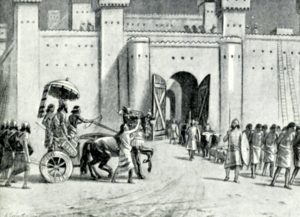
In 733 BC, Tiglath-Pileser decided to secure his conquests. He campaigned again against Aram-Damascus. It was still the strongest local state. Tyre, Ashkelon, and Israel supported Aram-Damascus. In 732 BC, Damascus fell. Tiglath-Pileser took over the lands of Aram-Damascus. In the same conflict, he captured Tyre and defeated Israel. He divided Israel in half. The northern part became the province of Megiddo. The southern part became a vassal kingdom. The weakening of Israel was seen by its people as proof of earlier prophecies.
Assyria's expansion brought Tiglath-Pileser's armies into contact with Arab tribes. Several of them started paying tribute. In 733 BC, Tiglath-Pileser campaigned against the Qedarites south of Damascus. He wanted to strengthen his control of southern Syria. The surprise attack caught the Qedarite queen Samsi off guard. The Qedarites were easily defeated. Tiglath-Pileser won, but he knew he could not rule the Qedarite lands directly. So, he let Samsi remain in control. An Assyrian official supervised her political actions.
Taking Over Babylonia
Later in his reign, Tiglath-Pileser focused more on Babylonia in the south. Babylonia had once been a large and powerful kingdom. It had competed with Assyria for centuries. But during the Neo-Assyrian period, it was usually weaker. Babylonia suffered from a lack of a strong army and internal divisions. Babylonians lived in most of the main southern cities. But Chaldean tribes, led by chieftains who often fought each other, controlled most of the southernmost land. Arameans also lived on the edges of settled areas. They were known for plundering nearby lands. Tiglath-Pileser kept track of events in the south through his agents.
In 731 BC, a Chaldean chieftain named Nabu-mukin-zeri took power in Babylon as king. Tiglath-Pileser saw this as a challenge to Assyrian power. Nabu-mukin-zeri wanted to unite Babylonia. Tiglath-Pileser spent the next few years defeating Nabu-mukin-zeri and his supporters. First, Assyrian armies blocked Babylonia's eastern border. This stopped Nabu-mukin-zeri from getting help from Elam. Elam often opposed Assyrian interests. Then, Tiglath-Pileser defeated many Aramean clans and Chaldean tribes.
The fight for Babylonia began in 730 BC. Assyrian messengers went to Babylon. They urged the people to open their gates and surrender. They said the king would give them forgiveness and tax benefits. The Babylonians refused. Nabu-mukin-zeri was not in Babylon. He was likely leading the war from his home city, Sapia.
In 729 BC, Tiglath-Pileser captured Babylon. He declared himself king of both Assyria and Babylon. He was the first Assyrian king to be recognized as such by the Babylonians. Nabu-mukin-zeri lost Sapia in the same year. But he seems to have kept fighting Tiglath-Pileser until 728 BC. As the new king, Tiglath-Pileser received tribute from the most powerful Chaldean tribes. These included the Bit-Dakkuri and Bit-Yakin. The Bit-Yakin tribe was led by Marduk-apla-iddina II. He would become a strong enemy of Assyria after Tiglath-Pileser's reign.
Unlike many other Assyrian conquests, Babylonia was not divided into provinces. It remained a full kingdom, ruled by the same king as Assyria. This was mainly because Assyrians greatly respected Babylonian culture and religion. Because of this respect, Tiglath-Pileser worked to make the people accept Assyrian rule. He took part in the important New Years' Akitu festival twice. This festival required the king to be present. He also led campaigns against Chaldean strongholds in the far south that resisted his rule.
Family and Who Came Next
Tiglath-Pileser's queen was named Iaba. Her name was not from the Akkadian language. It might have come from Arab or West Semitic (Levantine or Aramean) origins. Some experts think she might have been a princess from the Kingdom of Judah. This idea is based on the name of a later queen, Atalia, who might have been related to Iaba. Atalia's name is similar to Athaliah, a Judean queen. Also, the ending of Atalia's name might relate to the god Yahweh. This idea has supporters and opponents. Iaba's tomb was found in Nimrud in 1989.
Tiglath-Pileser is thought to have died peacefully from old age. His son, Shalmaneser V, became king after him. During Tiglath-Pileser's reign, Shalmaneser was known by his birth name, Ululayu. "Shalmaneser" was the regnal name he took in 727 BC. Shalmaneser likely joined his father in some campaigns. Many letters from him to his father exist. They often report on the lands he governed.
Shalmaneser was replaced as king after only a few years by Sargon II. He was probably removed from power and killed. Assyrian king lists say Sargon was Tiglath-Pileser's son. But most of Sargon's own writings say he was chosen by the god Ashur. Many historians accept that Sargon was Tiglath-Pileser's son. But they do not believe he was the rightful heir after Shalmaneser. If Tiglath-Pileser was Sargon's father, he also had a third son, Sin-ahu-usur. Sin-ahu-usur is mentioned as Sargon's younger brother. In 714 BC, he was given command of Sargon's royal cavalry guard.
Tiglath-Pileser's Lasting Impact
Historians call Tiglath-Pileser's reign a "watershed" in Middle Eastern history. This means it was a very important turning point. His rule is seen as the start of a completely new era of Assyrian expansion. He is the first Assyrian king mentioned in the Hebrew Bible and other ancient records. This means we have outside views of his reign. The Bible ignores all Mesopotamian history before him. The Bible records his impact on the Kingdom of Israel and events from the perspective of the southern Kingdom of Judah.
Tiglath-Pileser greatly expanded Assyrian territory. By the time he died, he had more than doubled the size of the Neo-Assyrian Empire. His way of ruling conquered lands directly, by making them Assyrian provinces, changed the empire's economy. Before him, Assyrians relied on tribute from vassal kingdoms. After him, they depended more on taxes collected by provincial governors. This cost more to manage but reduced the risk of revolts. It also meant less need for military action.
Many experts believe Assyria truly became an "empire" during Tiglath-Pileser's reign. This is because of its huge size, many different peoples and languages, and new ways of economic and political control. The power Assyria gained under him often makes it the first world empire in history. This means it was an empire without any real competitors. It ruled most of the world known to the Assyrians. The Assyrian Empire became a model for later empires in the Middle East and elsewhere. This was mainly because of Tiglath-Pileser's new ideas for ruling an empire.
The Assyrian resettlement policy grew stronger under Tiglath-Pileser. It continued under his successors and had huge effects. First, it led to big improvements in irrigation in the provinces. People who were moved were tasked with bringing Assyrian farming methods to their new homes. This led to more wealth across the empire. In the long run, moving people changed the cultural and ethnic makeup of the Middle East forever. Over time, the Aramaic language became the common language of the region. It stayed that way until the 14th century AD. Aramaic was the most widely spoken and understood of the empire's Semitic languages. Even during Tiglath-Pileser's reign, Aramaic became an official language. This is shown in reliefs from his time. They show the king using both Aramaic and Akkadian scribes to write down messages.
Titles
In an inscription from Nimrud, Tiglath-Pileser used these titles:
- King of Assyria
- King of Babylon
- King of Sumer and Akkad
- King of the Four Corners of the World
- King of the Universe
Images for kids
See also
 In Spanish: Tiglatpileser III para niños
In Spanish: Tiglatpileser III para niños


